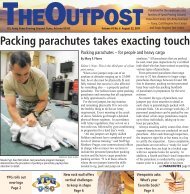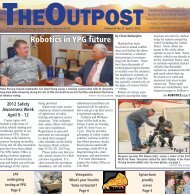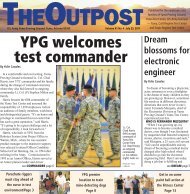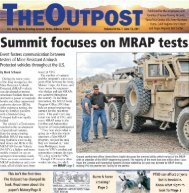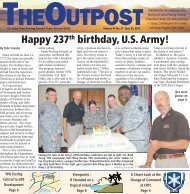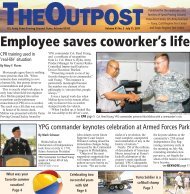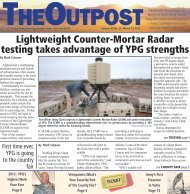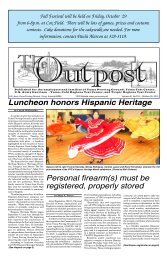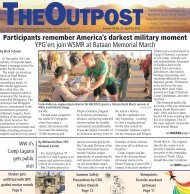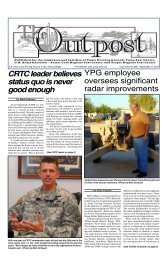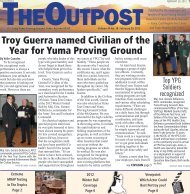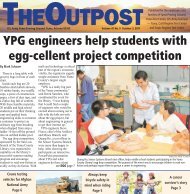YPG's new Candlewood Suites a 'dream-come-true'
YPG's new Candlewood Suites a 'dream-come-true'
YPG's new Candlewood Suites a 'dream-come-true'
You also want an ePaper? Increase the reach of your titles
YUMPU automatically turns print PDFs into web optimized ePapers that Google loves.
4 SEPTEMBER 3, 2012 THE OUTPOST<br />
By Bill Heidner<br />
The Army’s famed Camel Corps<br />
(circa 1856-1866) is really a<br />
misnomer. It never actually existed<br />
as a “corps,” rather, it should be<br />
seen as an experiment to solve a<br />
vexing transportation problem of its<br />
day. That problem was the Desert<br />
Southwest and the solution was to<br />
import camels to determine their<br />
suitability for use for “military<br />
purposes.” In today’s terms, it was<br />
a rapid fielding initiative using a<br />
commercial off-the-shelf solution<br />
(COTS) undergoing operational<br />
testing prior to fielding.<br />
COTS is an attractive idea for a<br />
number of reasons. It may save a ton<br />
of money in development costs. It<br />
could save lots of time and allow for<br />
rapid fielding to those who needed<br />
a solution yesterday. Of course,<br />
fielding COTS without conducting<br />
a proper test and evaluation to<br />
determine the suitability of the item<br />
to meet requirements and needs is<br />
dicey at best.<br />
By definition, developmental<br />
testing is not absolutely required; but<br />
operational testing may be just the<br />
Here is a chance meeting between Beale’s<br />
expedition, with some camels, and the Colorado<br />
River steamship “General Jessup” at what<br />
would then be called Beale’s Crossing. Today,<br />
this crossing site is located a bit north of the<br />
I-40 bridge in Needles, Calif. LOANED IMAGES<br />
Testing for a transportation<br />
solution; The Army’s Camel Corps<br />
ticket. For all of these reasons the<br />
War Department sought and, in 1856,<br />
received a $30,000 appropriation to<br />
purchase “dromedaries and camels.”<br />
The experiment itself represents a<br />
relatively short chapter in America’s<br />
history. Lasting “officially” from<br />
1856 to about 1866, it is as much a<br />
story of our nation’s need to expand<br />
westward as it is about the usefulness<br />
of camels to the Army. The<br />
experiment is largely held to have<br />
been a failure; but was it a failure<br />
of the capabilities of the camels or<br />
something else?<br />
Interest in the military use of<br />
camels in North America began in<br />
1836 with several papers circulated<br />
within the Army. Maj. Henry<br />
Wayne’s letter of 1848 caught<br />
the attention of the senator from<br />
Mississippi, Jefferson Davis. It<br />
wasn’t until 1855 when Davis<br />
became Secretary of War that<br />
Congress moved favorably with an<br />
appropriation. Wayne was placed<br />
in charge of the program and Lt.<br />
David Porter of the Navy was tasked<br />
to assist with the procurement of<br />
“dromedaries and camels” from the<br />
Levant. In all, Porter would bring 75<br />
camels to the United States, most of<br />
them considered to be dromedaries.<br />
Camp Verde, located about 60 miles<br />
northwest of San Antonio, Texas, was<br />
designated as headquarters for the<br />
experiment. Wayne reported directly<br />
to the Secretary of War and had<br />
complete control of the appropriation.<br />
The first load of 33 camels came<br />
ashore at Indianola, Texas, and made<br />
quite a stir as they moved to their<br />
<strong>new</strong> home. Porter returned to the<br />
Levant to procure the second group<br />
of camels while Wayne set about<br />
getting them acclimated and ready for<br />
the next phase of the test.<br />
It is perhaps here that the test<br />
program began to unravel. Wayne<br />
wanted to take time to develop<br />
a stronger breed of camel based<br />
on the Persian custom of cross<br />
breeding dromedaries with Bactrian<br />
camels to produce the “Tuili”<br />
variation. Secretary of War Davis,<br />
however, wanted the testing to<br />
begin immediately. The pending<br />
presidential election would almost<br />
certainly result in a <strong>new</strong> cabinet and<br />
Davis was anxious to show results<br />
from the $30,000.00 appropriation.<br />
Wayne was recalled to Washington<br />
and reassigned duties in the<br />
Quartermaster Department just as<br />
Porter was arriving with the second<br />
group of camels and camel drivers.<br />
When the presidential election took<br />
place, it did result in a change in<br />
administration.<br />
New Secretary of War James<br />
Floyd liked the camel idea and he,<br />
too, was anxious to get on with<br />
the test. For this, he chose Lt. Ed<br />
Beale, a former Navy officer who<br />
had a contract to develop a wagon<br />
road from Fort Defiance to the<br />
Colorado River, roughly following<br />
the 36th parallel. Floyd additionally<br />
tasked Beale to pick up 25 camels at<br />
Camp Verde and to test them as he<br />
developed the road.<br />
Beale found the camels to be<br />
excellent beasts of burden on this<br />
trip. He and his business partner,<br />
Samuel A. Bishop, also used the<br />
Army’s camels for several surveying<br />
missions from 1858 to about 1861.<br />
In Texas, the lack of a program<br />
manager and trouble accessing the<br />
funds for the camels, had often left<br />
the more than 50 camels there as idle<br />
beasts enjoying a steady diet of good<br />
hay and oats at the Army’s expense.<br />
Notably, these camels were taken<br />
out and used to survey areas of West<br />
Texas and the areas known today as<br />
the Big Bend.<br />
In all cases, those who actually<br />
used the camels were much<br />
impressed by their qualities. Beale<br />
noticed that as the arduous trip across<br />
the New Mexico / Arizona Territory<br />
progressed, the camels got stronger<br />
while the Army’s horses and mules<br />
became weaker. The soldiers using<br />
the camels in Texas noted similarly<br />
good results. In all cases, those who<br />
were left to take care of idle camels,<br />
which was the rule rather than the<br />
exception, hated the beasts.<br />
The advent of the Civil War<br />
doomed the experiment once and for<br />
all. Sponsored by the person who<br />
was now president of the Confederate<br />
States of America, senior Army<br />
leadership, especially Quartermaster<br />
General of the Army Montgomery<br />
Meigs, had no interest in sustaining<br />
the camel experiment. The camels<br />
in California and the few at Fort<br />
Yuma were sold off in 1863. The<br />
Texas camels were “captured” by<br />
the Confederate army and returned<br />
to U.S. control at the end of the war.<br />
That herd had grown in size, but<br />
had done little to suggest that the<br />
experiment should continue. They<br />
were sold off in 1866.<br />
This past June, over 112 people<br />
gathered at the Yuma Main Library to<br />
enjoy a presentation on the camels.<br />
Encore performances are already<br />
being arranged for next spring at<br />
several venues around town. For<br />
more information about the camels,<br />
contact Bill Heidner at 328-3394, or<br />
simply look forward to attending one<br />
of the spring-time presentations.



